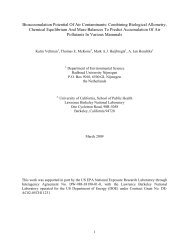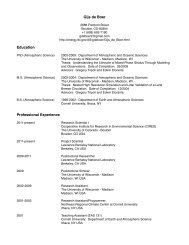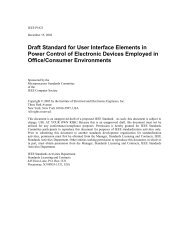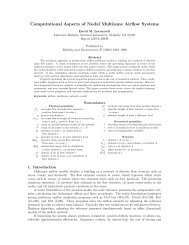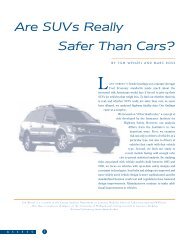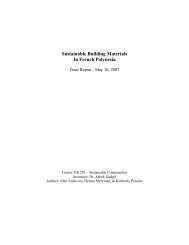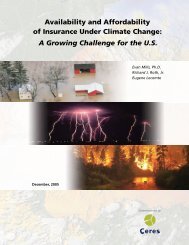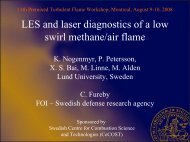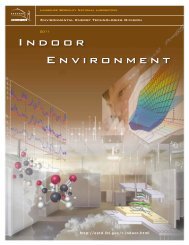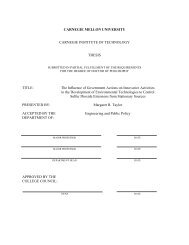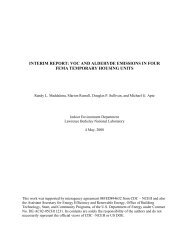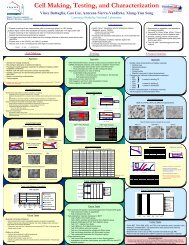indoor-outdoor air leakage of apartments and commercial buildings
indoor-outdoor air leakage of apartments and commercial buildings
indoor-outdoor air leakage of apartments and commercial buildings
You also want an ePaper? Increase the reach of your titles
YUMPU automatically turns print PDFs into web optimized ePapers that Google loves.
7.1. Current Knowledge<br />
Buildings are <strong>of</strong>ten divided into two categories: places where people live, which we call<br />
"residential" <strong>buildings</strong>, <strong>and</strong> places where people work, which we will call" <strong>commercial</strong><br />
<strong>buildings</strong>" although this is not technically the correct term (since government <strong>buildings</strong>, schools<br />
<strong>and</strong> other non-<strong>commercial</strong> <strong>buildings</strong> are also workplaces).<br />
Residential <strong>buildings</strong> can be divided into (1) single-family houses <strong>and</strong> (2) multi-family<br />
residences. Commercial <strong>buildings</strong> (as we have defined them above) can be divided into many<br />
sub-categories: <strong>of</strong>fice <strong>buildings</strong>, small or large retail <strong>buildings</strong>, schools, etc.<br />
Of all <strong>of</strong> the many categories <strong>and</strong> sub-categories <strong>of</strong> <strong>buildings</strong>, the only category for<br />
which <strong>air</strong> exchange rates <strong>and</strong> <strong>leakage</strong> parameters are well known is single-family detached<br />
houses. Vast amounts <strong>of</strong> data are available for single-family homes, mostly as a result <strong>of</strong><br />
"energy audit" programs that seek to quantify house leakiness or identify leaky homes in order<br />
to implement energy efficiency programs. The available data are subject to selection bias <strong>and</strong><br />
other problems, but the overall picture is characterized well enough that most practical<br />
questions that rely on knowledge <strong>of</strong> the statistical distribution <strong>of</strong> house <strong>leakage</strong> parameters can<br />
be answered (Chan et al., 2005).<br />
In contrast, the overall situation for <strong>commercial</strong> <strong>buildings</strong> <strong>and</strong> for apartment <strong>buildings</strong><br />
is: data are sparse, <strong>and</strong> there are complications in both measuring <strong>and</strong> conceptualizing building<br />
<strong>leakage</strong> because some <strong>commercial</strong> <strong>buildings</strong> are compartmentalized into discrete stores, <strong>of</strong>fices,<br />
etc. in such a way that <strong>air</strong> exchange between compartments can interact with <strong>air</strong> exchange<br />
between the building <strong>and</strong> the <strong>outdoor</strong>s. One implication <strong>of</strong> the interaction between <strong>indoor</strong> flow<br />
<strong>and</strong> <strong>indoor</strong>-<strong>outdoor</strong> <strong>air</strong> exchange is that it is difficult to predict the <strong>air</strong> exchange rate as a<br />
function <strong>of</strong> wind, <strong>indoor</strong>-<strong>outdoor</strong> temperature, <strong>and</strong> building <strong>leakage</strong> parameters. In contrast, in<br />
single-family homes, which are small in absolute size <strong>and</strong> which have large surface-to-volume<br />
ratio, very simple formulae relate the environmental conditions <strong>and</strong> <strong>leakage</strong> parameter to the<br />
<strong>air</strong> change rate. This is not true for more complex <strong>buildings</strong>.<br />
Persily (1999) has shown that, contrary to expectation <strong>of</strong> some experts, <strong>air</strong> infiltration is<br />
significant in <strong>commercial</strong> <strong>buildings</strong>. VanBronkhorst et al. (1995) estimate that infiltration<br />
accounts for 10% to 20% <strong>of</strong> the heating load in all <strong>of</strong>fice <strong>buildings</strong> nationwide, although they<br />
estimate it to have little effect on cooling loads, in part because <strong>of</strong> lower winds <strong>and</strong> lower<br />
<strong>indoor</strong>-<strong>outdoor</strong> absolute temperature difference in summer compared to winter.<br />
Although <strong>air</strong> infiltration in <strong>commercial</strong> <strong>buildings</strong> is significant, the <strong>air</strong> exchange rate due<br />
to HV AC operation is almost always larger than the <strong>air</strong> infiltration rate. Therefore, removal <strong>of</strong><br />
<strong>indoor</strong> pollutants, delivery <strong>of</strong> <strong>outdoor</strong> pollutants, <strong>and</strong> energy costs are largely determined by<br />
the details <strong>of</strong> HV AC design <strong>and</strong> operation. Moreover, since HV AC systems <strong>of</strong>ten mix <strong>air</strong> from<br />
different parts <strong>of</strong> the building, <strong>and</strong> deliver <strong>outdoor</strong> <strong>air</strong> approximately equally to different parts<br />
<strong>of</strong> the building, predicting <strong>indoor</strong> exposures to <strong>outdoor</strong> pollutants can be done f<strong>air</strong>ly accurately<br />
using knowledge <strong>of</strong> HV AC operation alone. For these reasons it is somewhat underst<strong>and</strong>able<br />
that little effort has gone into modeling <strong>air</strong> infiltration rates in <strong>commercial</strong> <strong>buildings</strong>, or into<br />
experiments to determine the relationship between building leakiness <strong>and</strong> <strong>air</strong> exchange for<br />
14



